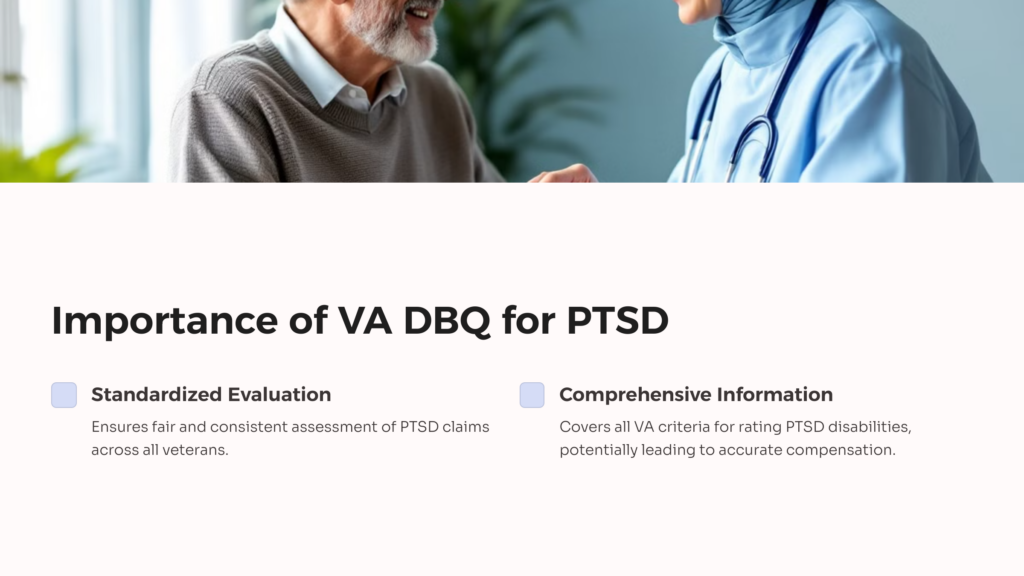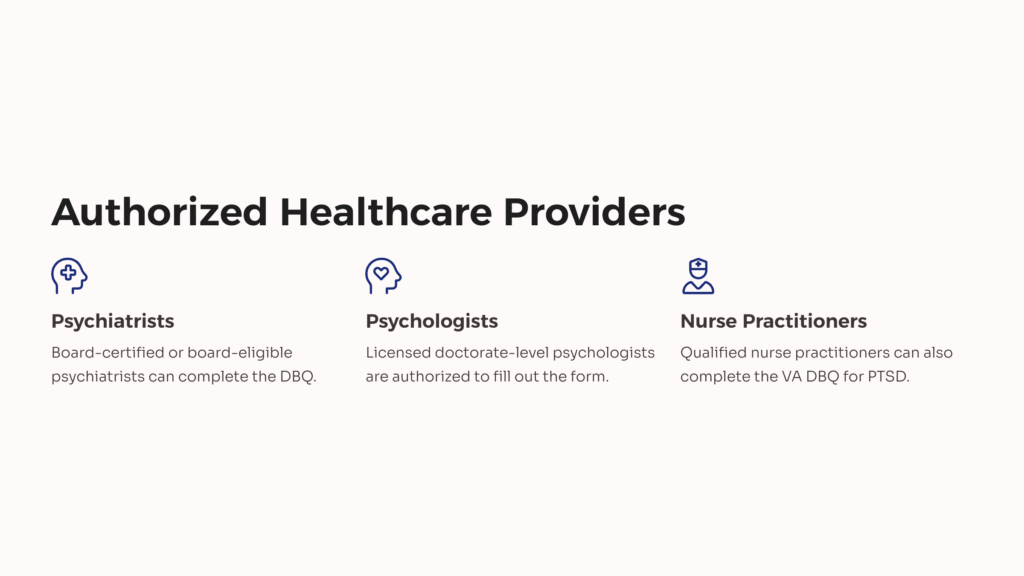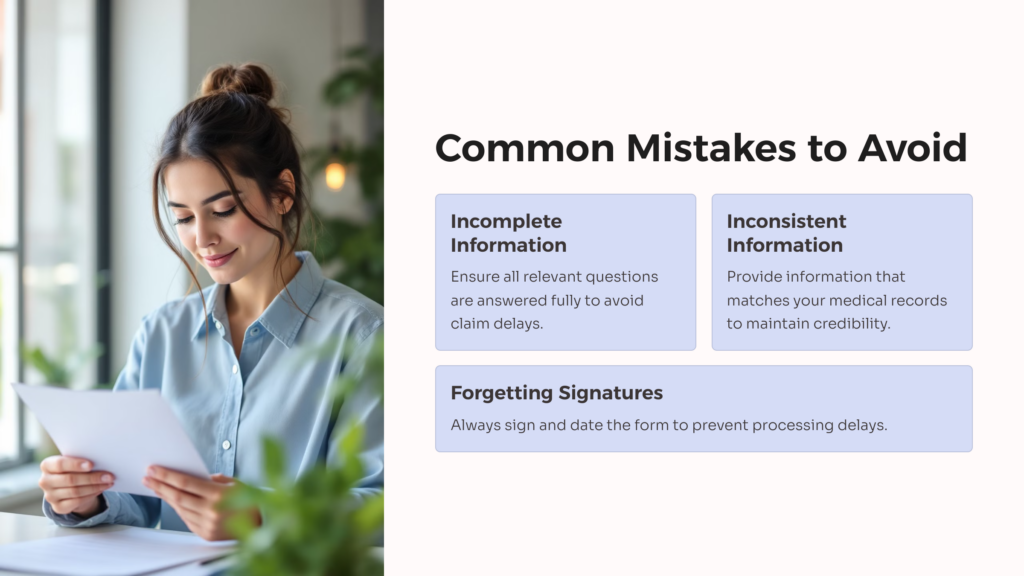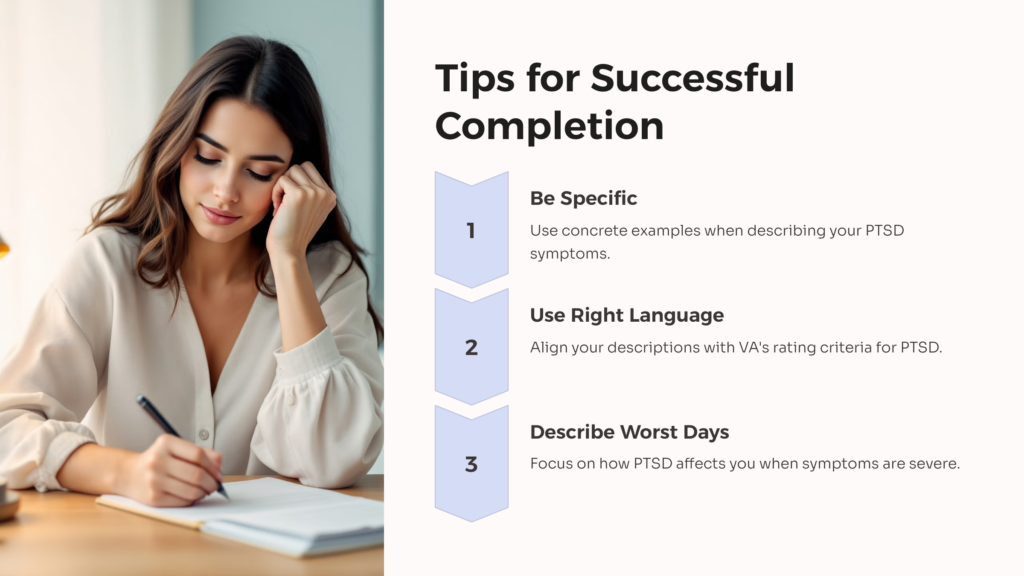A VA DBQ for PTSD, or Veterans Affairs Disability Benefits Questionnaire for Post-Traumatic Stress Disorder, is a crucial document in the VA disability claims process. This form helps veterans provide detailed information about their PTSD symptoms and how they affect daily life. The DBQ is designed to capture specific medical evidence that the VA needs to evaluate a veteran’s claim for PTSD-related disability benefits.
The DBQ for PTSD is a standardized form that asks targeted questions about a veteran’s mental health symptoms, treatment history, and how PTSD impacts their work and personal relationships. It covers areas like recurring memories, avoidance behaviors, changes in mood and thinking, and heightened reactions. By using this form, the VA aims to get consistent and thorough information from all veterans claiming PTSD benefits.
Veterans can have their healthcare provider fill out the DBQ, or in some cases, they may complete it themselves. The form is then submitted as part of the disability claim, giving VA raters the information they need to make fair decisions about benefits.
Why the VA DBQ for PTSD is Important

The VA DBQ for PTSD plays a critical role in the disability claims process for several reasons. First and foremost, it provides a standardized way to collect and present medical evidence related to PTSD. This standardization helps ensure that all veterans are evaluated fairly and consistently, regardless of where they live or who examines them.
By using the DBQ, veterans can make sure that all relevant information about their PTSD is included in their claim. The form covers all the criteria the VA uses to rate PTSD disabilities, so nothing important is left out. This completeness can lead to more accurate ratings and, potentially, higher disability compensation for veterans who are severely impacted by their PTSD.
Another key benefit of the DBQ is that it can speed up the claims process. When all the necessary information is provided upfront in a format the VA is familiar with, it reduces the need for follow-up questions or additional exams. This can help veterans get their benefits more quickly, which is especially important for those struggling with the effects of PTSD.
Steps to Complete the VA DBQ for PTSD
Completing the VA DBQ for PTSD involves several important steps:
1. Obtain the correct form: You can download the PTSD DBQ from the VA’s website. Make sure you have the most recent version.
2. Gather relevant medical records: Collect any medical records related to your PTSD diagnosis and treatment. These will help you or your healthcare provider fill out the form accurately.
3. Schedule an appointment: If a healthcare provider is completing the form, schedule an appointment specifically for this purpose. Let them know in advance that you need the DBQ filled out.
4. Be honest and thorough: Whether you’re filling it out yourself or with a provider, be honest about your symptoms and how they affect your life. Don’t downplay or exaggerate your condition.
5. Review the completed form: Make sure all sections are filled out completely and accurately. If anything is unclear or seems incorrect, ask for clarification or corrections.
6. Submit the form: Include the completed DBQ with your disability claim or appeal. Keep a copy for your records.
Remember, the goal is to provide a clear, accurate picture of how PTSD affects your life. Take your time and be as detailed as possible when describing your symptoms and their impact.
Who Can Fill Out a VA DBQ for PTSD?

The VA has specific guidelines about who can complete a DBQ for PTSD. Generally, the following healthcare providers are authorized to fill out this form:
- Board-certified or board-eligible psychiatrists
- Licensed doctorate-level psychologists
- Psychiatry residents under close supervision of an attending psychiatrist or psychologist
- Clinical or counseling psychologists completing a one-year internship or residency program
- Licensed clinical social workers
- Nurse practitioners
- Physician assistants
It’s important to note that while these providers can complete the DBQ, the VA might still require a Compensation and Pension (C&P) exam as part of the claims process. However, having a completed DBQ from your treating provider can provide valuable information to support your claim.
In some cases, veterans may be able to fill out parts of the DBQ themselves. However, the sections requiring medical opinions or diagnoses must be completed by a qualified healthcare provider. If you’re unsure about any part of the form, it’s best to seek help from a qualified professional or a Veterans Service Organization.
Common Mistakes to Avoid

When filling out the VA DBQ for PTSD, there are several common mistakes that veterans should be careful to avoid:
1. Incomplete information: Leaving sections blank or providing vague answers can delay your claim. Make sure every relevant question is answered fully.
2. Inconsistent information: Ensure that the information you provide matches your medical records. Inconsistencies can raise red flags and lead to further investigation.
3. Exaggerating symptoms: While it’s important to fully describe your symptoms, exaggerating them can harm your credibility. Be honest about your experiences.
4. Downplaying symptoms: On the flip side, some veterans minimize their symptoms out of pride or embarrassment. This can lead to an inaccurate assessment of your condition.
5. Not describing how PTSD affects daily life: The VA needs to understand how PTSD impacts your work, relationships, and daily activities. Be specific about these effects.
6. Forgetting to sign and date the form: This simple oversight can cause delays in processing your claim.
7. Not keeping a copy: Always keep a copy of your completed DBQ for your records.
By avoiding these common pitfalls, you can help ensure that your DBQ accurately represents your condition and supports your claim for benefits.
Tips for Successfully Completing the DBQ

To ensure your VA DBQ for PTSD is as effective as possible, consider these helpful tips:
1. Be specific and detailed: When describing your symptoms, use concrete examples. Instead of just saying you have trouble sleeping, explain how often you have nightmares, how long you typically stay awake, and how this affects your daily functioning.
2. Use the right language: Try to use terms that align with the VA’s rating criteria for PTSD. For example, mention specific symptoms like hypervigilance, avoidance behaviors, or difficulty concentrating.
3. Provide a complete history: Include information about when your symptoms started, how they’ve changed over time, and any treatments you’ve tried.
4. Describe your worst days: The VA wants to understand how PTSD affects you when your symptoms are at their most severe. Don’t just focus on how you feel on your best days.
5. Get help if needed: If you’re struggling to complete the form, don’t hesitate to ask for help from a Veterans Service Officer or a trusted healthcare provider.
6. Include supporting documents: If you have additional medical records, statements from family members, or other evidence that supports your claim, include these with your DBQ.
7. Review before submitting: Take the time to carefully review your completed DBQ. Make sure all information is accurate and complete.
Remember, the goal is to provide a clear, honest picture of how PTSD affects your life. By following these tips, you can help ensure your DBQ effectively supports your claim for benefits.
Understanding the VA C&P Exam for PTSD
The Compensation and Pension (C&P) exam is a crucial part of the VA’s evaluation process for PTSD claims. This exam is different from the DBQ, although it covers similar information. Here’s what you need to know:
The C&P exam is conducted by a VA-appointed healthcare provider, who may or may not be your regular doctor. During the exam, the provider will ask questions about your PTSD symptoms, how they affect your daily life, and your military experiences that may have led to PTSD. They’ll use this information to complete their own DBQ form.
It’s important to approach the C&P exam with honesty and openness. The examiner is there to assess your condition, not to provide treatment. Be prepared to discuss difficult topics and to describe how PTSD impacts various aspects of your life, including work, relationships, and daily activities.
Remember, the C&P exam is just one piece of evidence the VA will consider. Your personal DBQ, medical records, and other supporting documents are also important. If you disagree with the results of your C&P exam, you have the right to request another exam or to submit additional evidence.
Resources for Veterans: Where to Get Help
Navigating the VA disability claims process can be challenging, but there are many resources available to help veterans:
1. Veterans Service Organizations (VSOs): Organizations like the American Legion, Disabled American Veterans (DAV), and Veterans of Foreign Wars (VFW) offer free assistance with VA claims.
2. VA regional offices: Your local VA office can provide information and assistance with your claim.
3. Vet Centers: These community-based counseling centers offer a range of services, including help with VA benefits.
4. VA’s eBenefits portal: This online resource allows you to file claims, upload documents, and track the status of your claim.
5. National Center for PTSD: This VA program offers resources and information about PTSD treatment and research.
6. Veterans Crisis Line: If you’re struggling with PTSD symptoms, call 1-800-273-8255 and Press 1, text to 838255, or chat online for immediate help.
7. Legal aid organizations: Some organizations provide free or low-cost legal assistance to veterans with their VA claims.
Remember, you don’t have to navigate this process alone. Reach out for help if you need it. These resources are there to support you in getting the benefits you’ve earned.
FAQs About VA DBQ for PTSD
Here are some frequently asked questions about the VA DBQ for PTSD:
1. Q: Can I fill out the DBQ myself?
A: While you can provide information, sections requiring medical opinions must be completed by a qualified healthcare provider.
2. Q: How often do I need to submit a new DBQ?
A: You may need to submit a new DBQ if you’re claiming an increase in your disability rating or if the VA requests updated information.
3. Q: What if I don’t have a regular healthcare provider?
A: You can request a C&P exam through the VA, which will include completion of a DBQ.
4. Q: How long does it take to process a claim with a DBQ?
A: Processing times vary, but a complete and accurate DBQ can help speed up the process.
5. Q: What if I disagree with how my healthcare provider filled out the DBQ?
A: Discuss your concerns with your provider. If necessary, you can seek a second opinion or submit additional evidence to the VA.
Remember, if you have specific questions about your situation, it’s best to consult with a VSO or a VA representative for personalized guidance.
How the VA Evaluates the DBQ for PTSD
When evaluating a DBQ for PTSD, the VA follows a specific rating system outlined in the Code of Federal Regulations. This system assigns disability ratings based on the severity of symptoms and their impact on a veteran’s life.
The VA rates PTSD on a scale from 0% to 100%, with higher percentages indicating more severe impairment. They look at factors such as:
- Frequency and severity of symptoms
- Impact on work and social relationships
- Ability to perform daily activities
- Presence of specific symptoms like panic attacks or memory problems
It’s important to note that the VA considers the overall picture of how PTSD affects your life, not just individual symptoms. They also look for consistency between the DBQ, your medical records, and any C&P exam results.
The VA rater will use all this information to assign a disability rating. This rating determines the level of compensation you may receive. Remember, if you disagree with the rating decision, you have the right to appeal.
Submitting Your VA DBQ for PTSD
Once you’ve completed your VA DBQ for PTSD, the next step is to submit it as part of your disability claim. Here’s how to do it:
1. If you’re filing a new claim, include the DBQ with your initial application. You can do this online through the VA’s eBenefits portal, by mail, or in person at a VA regional office.
2. If you’re seeking an increased rating for an existing PTSD claim, you can submit the DBQ as new evidence. Again, this can be done online, by mail, or in person.
3. Make sure to keep a copy of the completed DBQ for your records.
4. If you’re submitting additional supporting documents, such as medical records or statements from family members, include these with your DBQ.
5. After submission, you can track the status of your claim through the eBenefits portal or by contacting your local VA office.
Remember, submitting a thorough and accurate DBQ can help speed up the processing of your claim. If you need assistance with submission, don’t hesitate to reach out to a Veterans Service Officer or a VA representative.
Legal Assistance and Advocacy for Veterans
While many veterans successfully navigate the VA claims process on their own or with the help of VSOs, some may benefit from legal assistance. This is particularly true for complex cases or appeals.
Several organizations provide free or low-cost legal services to veterans:
- The National Veterans Legal Services Program (NVLSP) offers pro bono representation to veterans and their families.
- Many law schools have veterans’ clinics that provide free legal assistance.
- Some private law firms specialize in veterans’ disability claims and offer contingency fee arrangements.
These legal professionals can help you understand your rights, gather necessary evidence, and present your case effectively. They can be especially helpful if you’re appealing a denied claim or seeking an increased rating.
Remember, while legal assistance can be valuable, it’s not always necessary. Start by exploring the free resources available through VSOs and the VA. If you feel your case is complex or you’re struggling with the process, then consider seeking legal help.
Advocacy groups also play a crucial role in supporting veterans. Organizations like the Iraq and Afghanistan Veterans of America (IAVA) and the Wounded Warrior Project work to improve policies affecting veterans and can provide additional resources and support.
By understanding your options for assistance and advocacy, you can ensure you’re getting the support you need throughout the claims process.
 AllVeteran.com Advisors
AllVeteran.com Advisors
With expertise spanning local, state, and federal benefit programs, our team is dedicated to guiding individuals towards the perfect program tailored to their unique circumstances.











